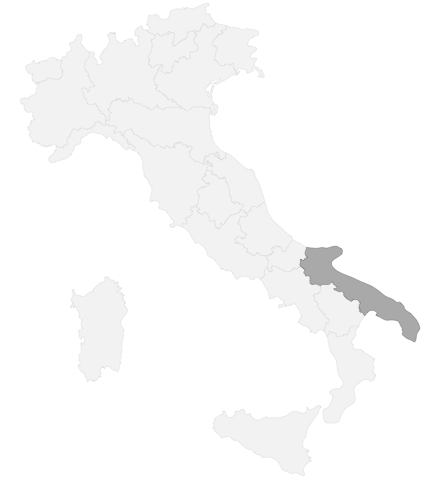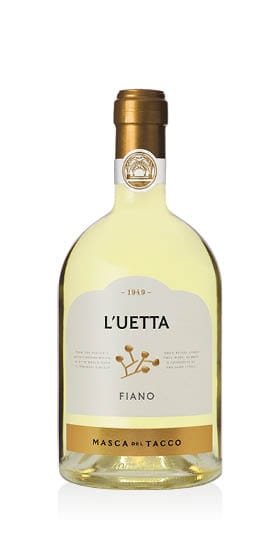Fiano, Apulia
Fiano is a white grape variety grown mainly in southern Italy in the regions of Campania, Sicily, Basilicata, Molise, Apulia. A diffusion that has Campania as its epicenter and that sees it migrate to Apulia and Basilicata well before the testimonies dating back to the nineteenth century. On the origin of the name Fiano it has been hypothesized a kinship with a population of the Apuans who, subjugated by the Romans in the second century BC, was forced to move to Sannio. Hence, the distribution of the Apuan vine, ancestor of Fiano in the Campania areas. With small clusters and able to guarantee low yields, Fiano produces excellent results when grown on volcanic soils, especially being able to enjoy excellent temperature ranges suitable for developing a great aromatic potential. With maturation between September and October, the Fiano is mostly aged in steel with partial maceration in contact with the skins or permanence in contact with the yeasts to ensure a soft and enveloping taste. The typical notes of Fiano range from white flowers such as acacia and wisteria, to white pulp fruits such as peach, pear, yellow melon, with slight herbaceous hints and pleasant acidity. It is an enveloping and soft wine, with a rich and complex finish, with a long persistence. Among the most important expressions appear in the appellations Fiano di Avellino DOCG, Cilento DOC and Sannio DOC.
Why buy Fiano
Buying Fiano certainly means taking a step back in time and seeing how local customs and traditions have been able to spread successfully to the point of being perfectly integrated into other climatic and cultural contexts. An excellent starting point when you decide to buy Fiano is clearly the Fiano d'Avellino with which you can get to know all the richness of Irpinia: with at least 85% of Fiano grapes it can even be accompanied by the mention 'Apianum' which recalls the ancient origin of the name.
Is there a Fiano red wine?
Fiano is a white grape variety and it is for this reason that the wines obtained can only be white wines, contrary to what happens with red grape varieties whose grapes can also be vinified in white.
Is Fiano a sparkling or still wine?
Fiano wine can be found on the market in both still and sparkling versions. The Terra d'Otranto DOC appellation includes a sparkling version produced with 90% Fiano grapes.
What are the main characteristics of Fiano wine?
Among the main organoleptic characteristics of the Fiano wine we certainly find a more or less intense straw yellow color that allows the nose to appear on the nose aromas of white pulp fruits such as peach, melon, pear, notes of cedar, chamomile and references of honey and sugared almonds. On the palate it is dense and enveloping with a discreet minerality, good acidity and an aftertaste characterized by pleasant green notes of mown grass and basil.
 Apulia is a land of sea and sun and the Apulian wine contains all its warmth. The vine has been cultivated in Apulia since ancient times, so much so that Pliny the Elder defined Manduria as viticulosa, that is, "full of vines". If in the past the wine was used as a "blending" wine to reinforce other wines, today Apulian wines are widespread and appreciated all over the world. Production is abundant and is close to 5000000 hectoliters. The native grapes are the protagonists, both in the whites with Fiano and Bombino Bianco, and in the reds with Primitivo, Negroamaro and Nero di Troia, which are sometimes part of the more famous and larger appellations, other times smaller and unknown.
Apulia is a land of sea and sun and the Apulian wine contains all its warmth. The vine has been cultivated in Apulia since ancient times, so much so that Pliny the Elder defined Manduria as viticulosa, that is, "full of vines". If in the past the wine was used as a "blending" wine to reinforce other wines, today Apulian wines are widespread and appreciated all over the world. Production is abundant and is close to 5000000 hectoliters. The native grapes are the protagonists, both in the whites with Fiano and Bombino Bianco, and in the reds with Primitivo, Negroamaro and Nero di Troia, which are sometimes part of the more famous and larger appellations, other times smaller and unknown.
Apulian red wine: fruit in its pure state
Apulian red wines are usually structured and juicy, with a strong fruity character. The most famous grapes are undoubtedly the Negroamaro (which gives soft and velvety reds, with a slightly bitter background) and the Primitivo, famous above all for the Primitivo di Manduria, which instead gives structured wines with a good alcoholic content and which seems a relative of Californian Zinfandel. Not to forget the Uva di Troia and the black Malvasia, also protagonist of the famous rosé wines of Salento and of a small and unknown appellation: the Cacc'e Mitte di Lucera. Also noteworthy are the sweet wines from red berried grapes, such as Primitivo liqueur and Salice Salentino Aleatico Passito, which manage to highlight the full potential of Apulian wines.
Apulian white wine: all the goodness of the earth
Apulia is known for its red wines, but there are also fine Apulian white wines, from the Locorotondo to the white Gravina passing through the Castel del Monte appellation. In this region there are both native grapes, such as Bombino Bianco, Malvasia Bianca and Verdeca, and international grapes, such as Chardonnay, which has found a happy island in Salento and is today one of the most widespread in the region. Apulian white wines are fresh and drinkable and for this reason they are easy to pair. From the white berried grapes are also born fabulous dessert wines, such as Moscato di Trani, which is present both as a sweet wine and as a straw wine.
What are the finest Apulian wines?
The most prestigious and famous Apulian wines are known all over the world and usually have large companies behind them: among the many, we cannot fail to mention the historic Five Roses by Leone De Castris (progenitor of the Salento rosé wines), the wines of the Tormaresca estate and above all the Primitivo di Gianfranco Fino, one of the most awarded and famous Apulian wines among wine lovers.
When were Apulian rosé wines born?
Apulian rosé wines are born with Leone De Castris' Five Roses: at the end of the last world war, the American general Charles Poletti, commissioner for supplies of the allied forces, asked for a large supply of rosé wine from the Leone De Castris winery. Thus was born a 100% Italian wine, but with a strictly American name: Five Roses (from the Cinque Vie district, not far from the Negroamaro vineyards that give life to this wine). A story full of successes, which today sees in this kind of rosé wines a must of the summer, in Italy and beyond.
What are the Apulian DOCG wines?
Apulian DOCG wines include three red wines, Castel Del Monte Bombino Nero DOCG, Castel del Monte Nero di Troia DOCG and Castel del Monte Rosso Riserva DOCG, as well as of course a sweet wine, the sweet natural Primitivo di Manduria DOCG. However, there are numerous DOC and IGT wines, scattered throughout the region from the Gargano to the extreme tip of Salento.












